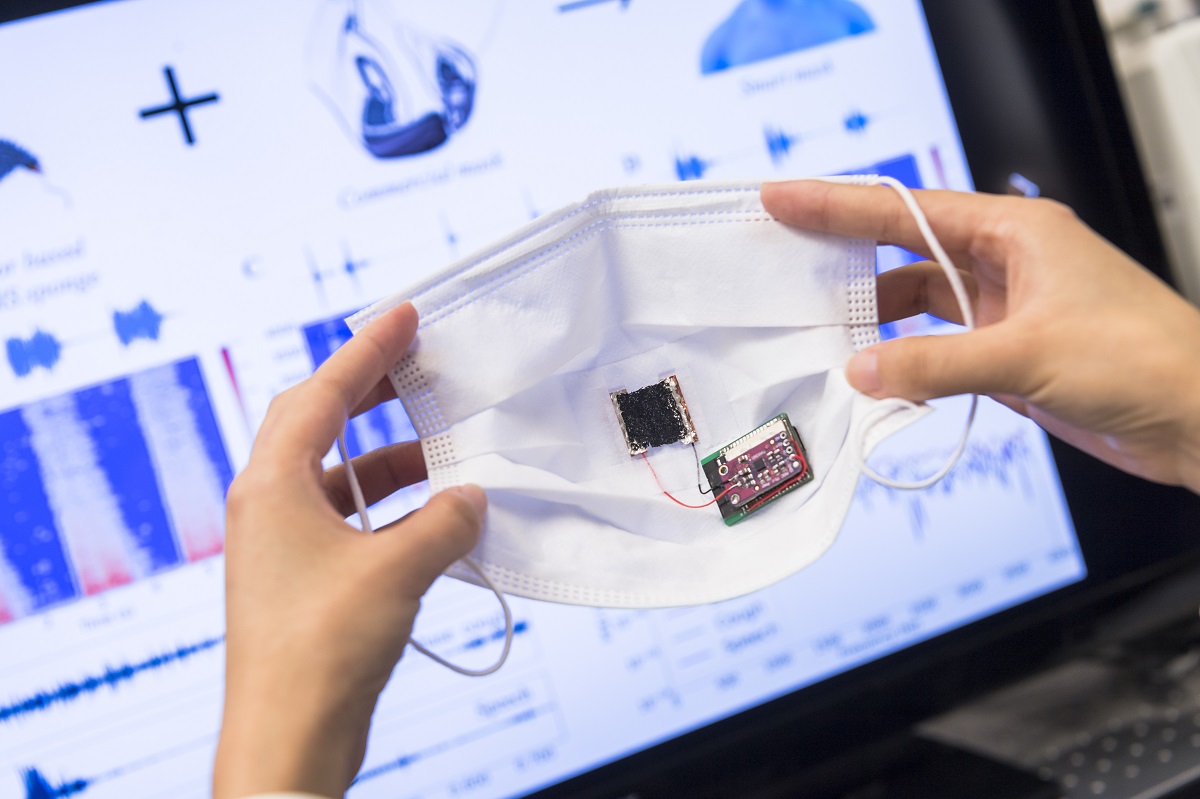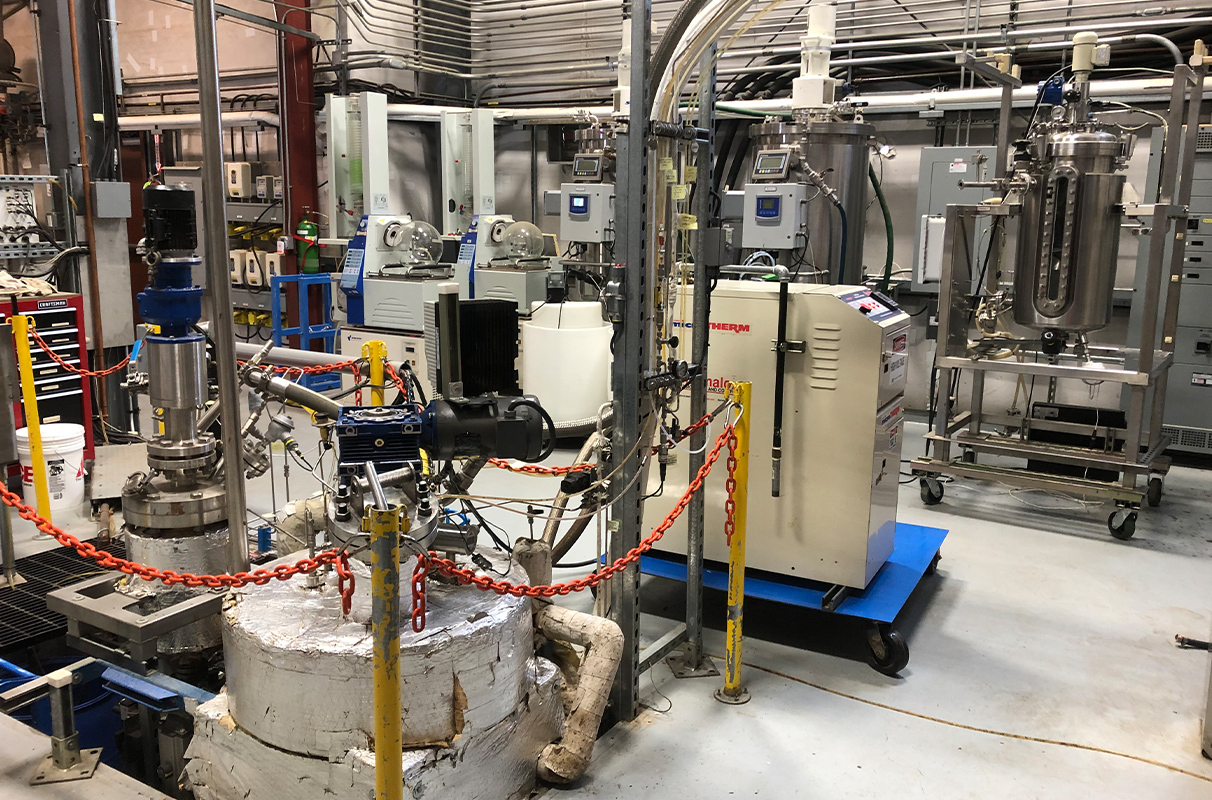
CityU’s smart mask will help improve personal and public health.
Credit: City University of Hong Kong
Wearing face masks has been recognised as one of the most effective ways to prevent the spread of COVID-19, even in its coming endemic phase. Apart from the conventional function of masks, the potential for smart masks to monitor human physiological signals is being increasingly explored. A research team led by the City University of Hong Kong (CityU) recently invented a smart mask, integrating an ultrathin nanocomposite sponge structure-based soundwave sensor, which is capable of detecting respiratory sounds of breathing, coughing and speaking.
Using machine-learning algorithms and a high sensitivity soundwave sensor operable across a wide bandwidth, the smart mask has opened new avenues for its application in the identification of respiratory diseases, as well as a voice interaction tool. This ultra-lightweight wearable technology also has the potential to improve personal and public health by enabling prolonged and systematic respiratory health monitoring in daily life.
A research team led by Professor Li Wenjung, Chair Professor in the Department of Mechanical Engineering (MNE), Professor Wang Jianping, Professor in the Department of Computer Science (CS), and Dr Yu Xinge, Associate Professor in the Department of Biomedical Engineering (BME) at CityU, recently developed this smart mask, which can detect and distinguish multiple respiratory actions. Professor Shen Jiangang’s team from the School of Chinese Medicine of The University of Hong Kong also made an important contribution to the project. The findings were published in Advanced Science under the title “Wide-bandwidth nanocomposite-sensor integrated smart mask for tracking multiphase respiratory activities”.
Nanocomposite-sensor integrated smart mask allows the detection of a wide-bandwidth dynamic pressure range with high sensitivity for tracking multiphase respiratory activity.
Importance of wearing masks even if COVID-19 becomes endemic
“Many countries now believe that COVID-19 will soon become endemic,” said Professor Li. “However, we must set aside optimism and be realistic about the likely levels of illness, disability and death associated with this disease in the coming years. It is important to remember that endemicity does not correspond to harmlessness.” He used malaria as an example to illustrate that even though it is currently considered endemic in 87 countries, in 2020, it infected an estimated 241 million people and caused 627,000 deaths, according to the World Health Organization. Thus, he suggested that people should continue to be cautious about COVID-19 and use available and proven measures, including masks, to control the spread of the virus.
This smart mask utilises our self-developed, high-sensitivity, wide-bandwidth flexible sensor that can detect and record daily human respiratory activity, such as breathing, coughing and speaking for cloud data storage,” explained Professor Li.
The smart mask developed by the team has a sponge-like structure as thin as 400?m, fabricated with carbon nanotube and polydimethylsiloxane (CNT/PDMS) materials, using the team’s novel modified sacrificial-release technique. The ultra-thin, lightweight sensor can be practically integrated and work effectively with both rigid masks and deformable non-woven fabric masks.
Good performance in static and dynamic pressure
The research team recruited 31 people in order to collect their respiratory activity while they wore the smart mask. The findings showed that the acoustic wave sensor was highly sensitive in measuring both static and dynamic pressure. Besides performing well in the static pressure range of 27.9 Pa – 2.5 kPa, the sensor also responded to high-frequency dynamic pressure generated by the human voice, i.e., sound harmonic acoustic energy up to 4000 Hz. In addition, the sensor can sense air movement, including directional flow and vibration. These findings suggest that the sensor could be used to detect human respiratory activity by integrating it with a commercial polycarbonate mask. It also demonstrated that the smart mask could detect and differentiate three common respiratory functions: breathing, coughing and speaking.
Advanced artificial intelligence technology enables the integrated mask to recognise different coughing and breathing patterns automatically, indicating its potential use to diagnose respiratory-related diseases in the future,” said Professor Wang. “Presently, researchers use commercial sensors to detect temperature changes and airflow to count the number of coughs, but they cannot capture important physiological information contained in the human voice, coughing and breathing. Our smart mask is sensitive to both subtle air pressure and high-frequency vibrations and can detect three phrases of coughing,” added Professor Li.
The team aims to eventually develop real-time diagnostics algorithms for applications such as pneumoconiosis symptom assessment. “As a potentially low-cost, daily smart wearable device, this new IoT smart mask will help personal and public health management of respiratory disease screening and diagnosis, especially in cities with a dense population, like Hong Kong,” said Dr Yu. The speech-detection ability of the smart mask can also help resolve the sound attenuation problem caused by wearing masks.
Original Article: CityU researchers invent smart mask to track respiratory sounds for respiratory disease identification
More from: City University of Hong Kong
The Latest Updates from Bing News
Go deeper with Bing News on:
Smart mask
- ICMR to fund smart mask project to detect TB in kids
Mumbai: An innovative mask developed by city scientists to painlessly detect tuberculosis (TB) among children has bagged funding from the Indian Counc.
- The Best Reusable Eye Masks For Puffiness And Dark Circles
It’s Earth Month so let’s talk about a small change that can make a big difference: choosing reusable eye masks over disposable ones. These masks work wonders for your under-eye area ...
- Best LED Face Masks for Glowing Skin in 2024, Dermatologist Recommended
Flexible masks are more comfortable and adapt to your ... and younger-looking face and neck. This LED wand is a smart and innovative device that can provide you with a quick and effective solution ...
- Mask-inspired perovskite smart windows enhance weather resistance and energy efficiency
Thermochromic perovskite is a new color switch material used in energy-saving smart windows. Despite its potential for energy savings, thermochromic perovskite suffers from poor weather resistance, ...
- The best celebrity- and dermatologist-backed LED face masks and devices
Whether they're giving the gift of self-care or primping prior to the red carpet, plenty of celebs rely on LED masks for a flawless glow. FilmMagic; Getty Images for Lionsgate; Omnilux ...
Go deeper with Bing News on:
Sensor integrated smart mask
- An Instrument-free CRISPR-based Face Mask Sensor for COVID-19
We have designed, developed, and validated a point-of-care lyophilized COVID-19 NAAT sensor that can be integrated into any face mask for detecting the virus from a user’s breath. The sensor employs ...
- 53 Cool Tech Gadgets For The Ultimate Smart Home
Combine the best of both worlds when it comes to this sleep mask! It effectively ... This universal smart button pusher is easy to install to any rocker switch or button in less than a minute. It can ...
- Textiles and Clothing News
2023 — A new durable copper-based coating can be precisely integrated into fabric to create responsive and reusable materials such as protective equipment, environmental sensors, and smart ...
- Why you need a smart home sensor for better security and automation
But one thing that’s very overlooked but can make a huge difference to the safety and security of your home is a smart sensor. With the latest news of Philips Hue expanding into security and ...
- Ceiling Fan Adds CO2 Sensor
Sure, you can get smart controllers for them to plug into ... but there is also a CO2 sensor integrated to improve this aspect of air quality when needed. The entire build is based on a Raspberry ...









